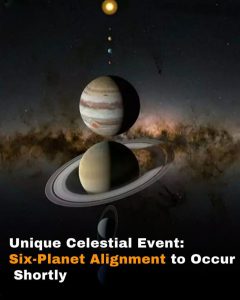

If you’re fascinated by the stars, the upcoming year offers a celestial treat that you won’t want to miss. The night sky will present a spectacular display to kick off the new year.
This past year has provided numerous chances to witness breathtaking astronomical events, including several sightings of the Northern Lights, April’s solar eclipse, and the supermoons, with the last being November’s Beaver Moon.
As 2025 begins, those interested in skywatching will have an exciting event to look forward to.
A rare planetary alignment is set to occur, featuring six planets with a seventh joining later. This alignment, where multiple planets appear to line up on the same side of the sun, will be visible from late January.
From January 21 to the end of February, spectators can observe Venus, Mars, Jupiter, Saturn, Neptune, and Uranus all aligning in the night sky.

In the Northern Hemisphere, the optimal viewing time for this celestial event is around 8.30pm local time. Venus, Saturn, and Neptune will be visible on the horizon for a short period after that, disappearing by around 11.30pm or midnight, depending on your location. In contrast, Mars, Jupiter, and Uranus will stay visible for several more hours, with Mars setting just before sunrise.
This alignment is anticipated to last up to four weeks due to the favorable positions of the planets in the sky. A week before February ends, Mercury will join the lineup, resulting in a seven-planet parade for a few days.
Observing all the planets simultaneously may be challenging, as Saturn, Mercury, and Neptune will be close to the sun at sunset. By early March, these planets will be too near the sun to be visible, followed by Venus. This leaves Jupiter, Mars, and Uranus to occupy the night sky until the next alignment.

When observing astronomical events, some standard guidelines should be followed. Choose a clear night, escape the city lights, and consider using UV protection for your eyes, especially in late February when some planets are close to the sun.
You can see Mars, Venus, Jupiter, and Saturn without special equipment, as they will be visible to the naked eye. However, Neptune and Uranus are too distant to be seen without a powerful telescope. A telescope with at least an 8-inch aperture at 50 times magnification is recommended to view Uranus and its rings, and a 150 times magnification will allow you to see Neptune and its rings.
If you’re not sure where to direct your gaze, several websites and apps can assist in locating the planets, including Stellarium’s website and apps for iOS and Android.


